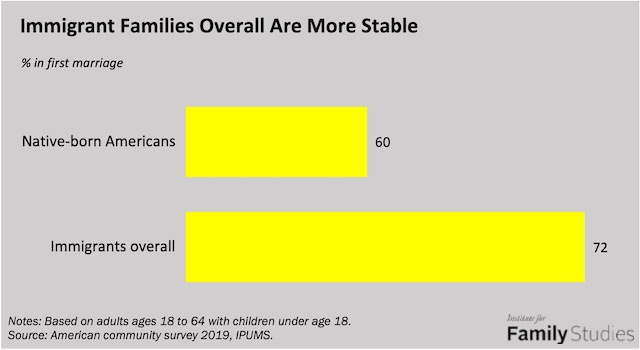Indian Americans Lead Immigrants in Family Stability, Education, and Income
- The report, released by the Institute of Family Studies, reveals higher marriage rates and lower divorce rates among immigrants.

Immigrant families tend to be more stable than native-born Americans, and Indian Americans, who are among the 30 largest groups of working-age immigrants in the U.S., rank at the top in family stability. They are also one of the most highly educated and financially successful immigrant groups. Seventy-two percent of immigrants with children are still in their first marriage, whereas this share among native-born Americans is just 60 percent. About 4 percent are remarried, and the share of unmarried Indian immigrants with children is only 2 percent. These are some of the key findings by a report, which analyzed census data, released by the Institute of Family Studies (IFS), and authored by Wendy Wang, director of research at IFS.
“Behind these numbers are the relatively higher marriage rates and lower divorce rates of immigrants in general,” the report says. For every 1,000 unmarried immigrants ages 18 to 64 in 2019, 59 got married. The corresponding number for native-born Americans was 39. Likewise, only 13 out of 1000 married immigrants ages 18-64 got a divorce in 2019, compared with 20 out of 1000 among native-born Americans of the same age.
However, the report notes that the share of intact marriage drops to 87 percent among native-born Indian Americans with children, “despite the fact that they have higher incomes than the first-generation Indian immigrants, and their educational levels are equally high. After controlling for education, income and age, Indian immigrants are more than twice likely to be in an intact family than native-born Indian Americans.”

Family stability is also higher among immigrants from other parts of Asia, such as Bangladesh, Pakistan, Taiwan, Korea, China, and Japan. More than 80 percent of immigrant families from these countries comprise two stably married adults with their children. Specifically, 72 percent of immigrants with children are still in their first marriage, whereas the share among native-born Americans is just 60 percent.
Family stability is primarily driven by higher education and higher income, the report observes. It gives an example of Immigrants from Asia, who tend to have higher educational levels than other immigrants as well as a higher family stability.
Family stability is primarily driven by higher education and higher income, the report observes. It gives an example of Immigrants from Asia, who tend to have higher educational levels than other immigrants as well as a higher family stability. More than six-in-ten Asian immigrants with children are college-educated (64%), compared with 13% of their Hispanic peers. This family stability is seen even within groups with lower levels of education and higher rates of poverty, the report notes. Compared with native-born American parents, however, immigrants with children overall have lower levels of education and higher rates of poverty.
This is also true when comparing first-generation immigrants and those who were born in the U.S. Native-born Asian Americans with children are less likely to be in a stable marriage than first-generation Asian immigrants (78 percent vs. 85 percent), even though their income is higher.

The report notes that along with education and income, culture makes immigrants stand out. “Immigrants are more likely than native-born Americans to embrace a family-first mindset when it comes to marriage and children.” In an IFS survey conducted in California, nearly 70 percent of immigrants said that it is very important for them to be married before having children, compared with 62 percent of native-born Californians. They also are more likely than native-born Californians to believe that couples with children should make every effort to stay married (50 percent vs.43 percent).
Noting that the individualism in American culture, despite its virtues, is at odds with stable marriage and families, the report says that immigrants embrace familism to not only provide them “a safe harbor when facing the challenges as newcomers, it also helps to provide a better environment for their children to advance in life.” This is evident in the school performances of children of immigrants.
Citing a July 2020 analysis by IFS senior fellow Nicholas Zill, the report says that children of immigrants are doing surprisingly well in school: they are more likely to get “As” and are less likely to have behavior problems. “The reason for their academic success is not because these children are from better-off families (in fact, the majority of them are not), it is partly because they are more likely to live in intact families with two married parents.”
In conclusion, the report observes that while immigrants “represent a diverse array of cultures and traditions,” what is common is “a dedication to family that translates into better performance in school and a stronger shot at realizing the American Dream.”


